Everyone should deadlift. If you’re a strength athlete, deadlifts (and their many variations) are non-negotiable. Bodybuilders who train to gain muscle and improve the quality of their physiques can also use the deadlift to develop their posterior chains.
You don’t have to be a devoted weightlifter to benefit from deadlifts, though. After all, the motion itself is as close to universal as it comes: Bend down, grab the object, and stand up with it. In fact, even if you don’t lift weights, you probably “deadlift” on a regular basis either around the house or at your job.
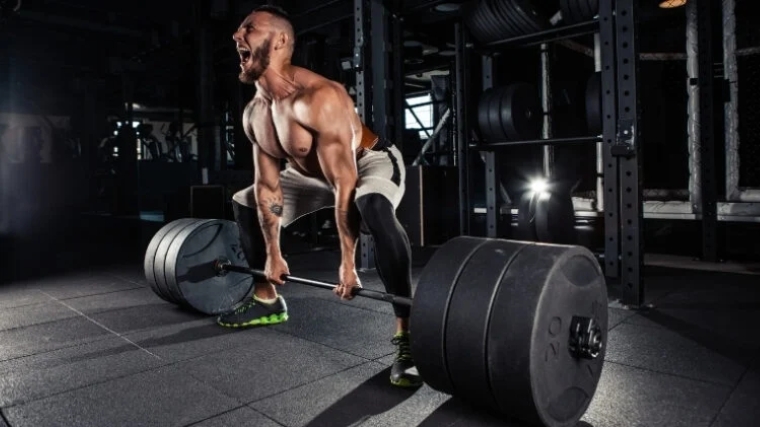
So, whether you already pull for athletic reasons or are dipping your toes into the gym for the first time, you should know what you stand to gain from mastering the deadlift. Here are a dozen of the most significant benefits of the deadlift, plus some fun training tips to help you get started.
Editor’s Note: The content on BarBend is meant to be informative in nature, but it should not be taken as medical advice. When starting a new training regimen and/or diet, it is always a good idea to consult with a trusted medical professional. We are not a medical resource. The opinions and articles on this site are not intended for use as diagnosis, prevention, and/or treatment of health problems. They are not substitutes for consulting a qualified medical professional.
What Are Deadlifts?
It’s perfectly normal to scratch your head a bit when you see the word “deadlift” — after all, the name of the exercise doesn’t really explain what it is. However, deadlifts are a pretty straightforward strength training exercise.
The act of deadlifting involves picking up, or lifting, a weight from a dead stop on the floor, without using any momentum to begin with. It’s really that simple. You can perform deadlifts with just about any kind of lifting equipment, including a barbell, dumbbells, kettlebells, a hexagonal trap bar, and so on.
[Related: The Best Full-Body Bodybuilding Workout You Can Do]
The standard deadlift involves loading a barbell with some weight plates, bending over, grabbing it, and standing up. But the surface-level simplicity of the deadlift belies the wide array of benefits underneath.
Top 12 Benefits of Deadlifts
Here are 12 of the biggest benefits of adding the deadlift (or one of its variations) into your training program:
- More Strength
- Full-Body Activation
- Stronger Legs
- A Stronger Lower Back
- More Calories Burned
- Releases Anabolic Hormones
- Better Core Strength
- Improved Athleticism
- Enhanced Endurance
- Better Posture
- More Grip Strength
- You Can Do Them (Almost) Anywhere
1. More Strength
A 2018 review published in MOJ Yoga & Physical Therapy explored the benefits of performing squats, deadlifts, and bench press had on strength and overall health. It concluded that a physiological response of the deadlift was whole-body strength, power, and sports performance. (1)
The deadlift has a much higher potential “ceiling” for strength gain than most other full-body exercises. You’ll get stronger in a hip hinge position but also make neurological strength adaptations that carry over to other compound movements such as the bench press and barbell squats.
2. It’s a Full-Body Workout
Although many people know that deadlifts work out your lower body, they also work out your upper body — albeit isometrically. Deadlifts engage your lower back, and upper back since those muscles support your torso as you pull weight from the floor. Your biceps will also be strained as they support your arms during the pull, and your shoulders will work hard to keep your arms locked into place.
3. The Deadlift Builds Stronger Legs
Deadlifts place a big emphasis on your lower body, including your glutes, quads, and hamstrings, resulting in strong and dense legs. Adding deadlifts to your training plan will take your leg strength to another level. One study found that subjects who did deadlifts twice per week for 10 weeks increased their rapid torque capacities in their knee extensors and flexors (aka quads and hamstrings), increasing their vertical jump. (2)
4. A Stronger, Healthier Lower Back
A strong, rock-solid lower back is important both in the weight room and everyday life. Your erector spinae muscles literally hold you upright when you walk and bear tremendous weight during rows, carrying movements, the deadlift, and much more.
Lower back pain also afflicts plenty of folks with sedentary lifestyles or chronic conditions. Fortunately, the deadlift may be a boon to your back. The Journal of Strength and Conditioning Research indicated that deadlift training might help reduce pain and disability in some patients with low back pain. (3)
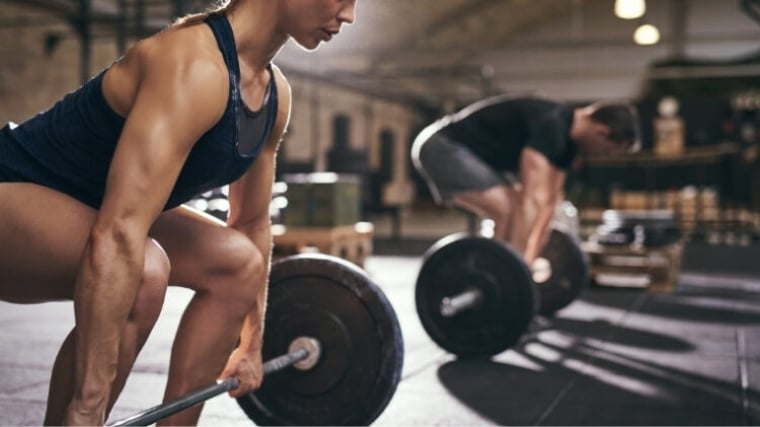
[Related: How to Build Your Own One-Rep Max Calculator]
Deadlifts are a very functional movement, meaning they help out with a lot of everyday tasks. This will reduce the chances of you injuring yourself whenever your carrying groceries, changing a tire, moving home furniture, and so on.
Also, since you’re getting a full-body workout in, you’re strengthening your muscles and preventing muscular imbalances since you’re making sure you work out both your upper and lower body.
5. You’ll Burn More Calories
The deadlift works a lot of muscles in your body, which burns more calories during your workout. And the more calories you burn, the more fat you lose. Moreover, deadlifts help build muscle, increasing your basal metabolic rate (BMR) — the number of calories you burn at rest. A 2014 study performed by the European Journal of Clinical Nutrition found an average of a five percent increase in subject’s metabolism after nine months of resistance training. (4)
6. They Release Anabolic Hormones
Since deadlifts recruit and stress many muscles, it causes the release of key anabolic hormones, such as testosterone and HGH. Having higher testosterone levels and HGH comes with a host of benefits, including more strength, muscle, energy, and improved libido. (5)
7. You’ll Have Better Core Strength
When you do deadlifts, you rely a lot on your core’s stability to lift the weight from the ground. Your core is also bracing hard to keep your spine rigid.
Actively bracing your core will make your core stronger for other exercises, including the bench press, overhead press, and single-leg deadlifts. Your core is responsible for facilitating movement, so having a strong core will carry over to everything you do.
8. Deadlifts Improve Athleticism
A 2011 study showed a link between core strength — which is bolstered by the deadlift —and improved athletic performance on a series of athletic tests, including the 40-yard dash, the T-test, vertical jump, and medicine ball throw. (6)
[Read More: Designing Your Own at-Home Workout Routine]
Another 2018 study by the Journal of Yoga and Physiotherapy reported that deadlifts might be more beneficial for horizontal-based sports movements that involve sprinting and jumping since a deadlift is applied to a perpendicular plane to the body but loaded in a horizontal plane. (7)
9. Enhanced Endurance
Although deadlifts are associated more with strength than conditioning, you can increase your muscular and cardiovascular endurance by increasing the number of reps and sets you do and decreasing the amount of rest in between sets.
Since deadlifts tax so many muscles, you’ll quickly find yourself keeled over after a few high-rep sets. The journal Sports Medicine found that deadlifts actually benefit the performance of endurance athletes. (8)
10. Better Posture
Deadlifts improve your posture by keeping your shoulders, spine, and hips in alignment. Since deadlifts require proper form, you’ll have to keep your shoulders squeezed back, spine straight, and hips mobile. Combined, these factors result in better posture. Improving your posture is vital as research shows that it can lead to back pain if left unfixed. (9)
11. You’ll Develop a Stronger Grip
Deadlifts require immense amounts of grip strength to hold onto the weight during the movement. Since you’re gripping heavy weights for a given rep range, you quickly increase your grip strength, which carries over into every exercise. Research indicates that grip strength is a solid biomarker for identifying older adults at risk of health problems. (10)
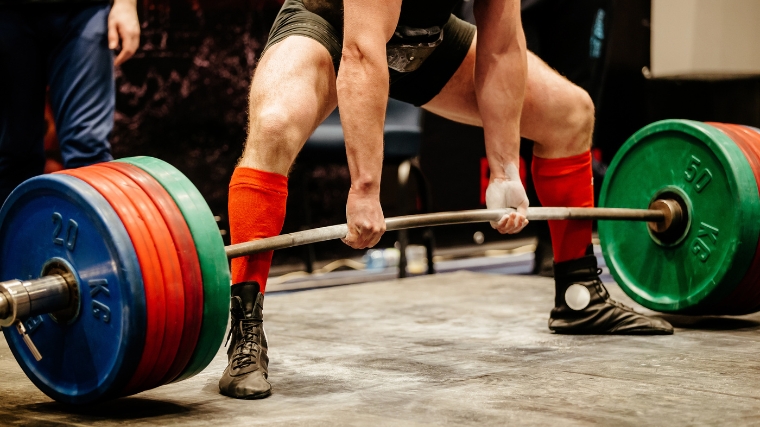
If you’re not doing deadlifts to enhance your grip, you can use a pair of lifting straps to take your grip out of the equation.
12. You Can Deadlift (Almost) Anywhere
If you’re not already sold on the deadlift’s physiological benefits, take a moment to consider the logistics of your workout routine. If you like to work out at home, you need an exercise that stimulates many different athletic qualities without requiring large, complex equipment. The deadlift checks that box.
If you train in a commercial gym, on the other hand, you know just how frustrating it can be to navigate a crowded weight room. A rude patron can derail your entire session by hogging a valuable piece of equipment.
Luckily, all you need to deadlift is a barbell and some open space. Heck, if you don’t have a barbell at your disposal, you can deadlift with heavy dumbbells, a trap bar, or even a kettlebell. No matter where — or why — you train, you can probably bang out some deadlifts.
How To Do the Deadlift
The deadlift is both simple and complex. At a glance, all you’re doing is picking up a barbell from the floor. Easy enough. However, there’s much more to the deadlift than meets the eye. A picture-perfect pull will enhance the benefits of the exercise and limit your risk of injury.
Here’s how to properly perform the barbell conventional deadlift. You’ll need a barbell, some full-sized weight plates, and some free space to work.
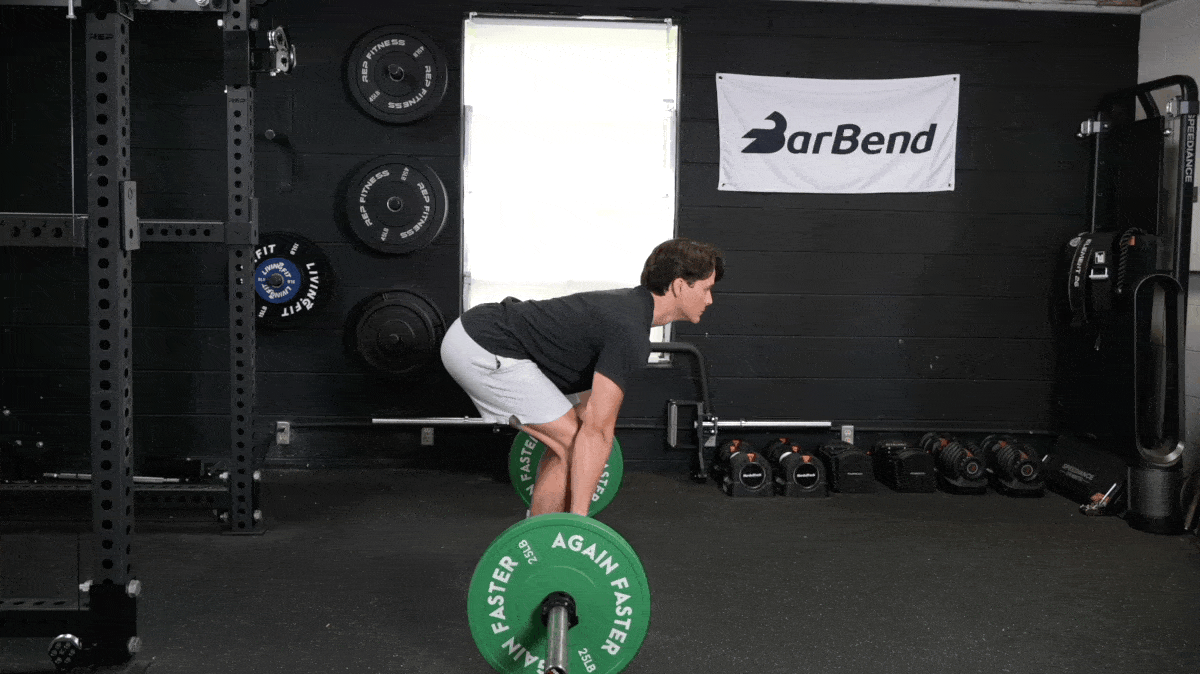
[Related: Everything You Need to Know to Build Your First Workout Program]
- Step 1: Step up to the barbell. Place your feet underneath it such that the bar is directly above the middle of your feet. There should be about an inch of space between the bar and your shins. Start with a hip-width stance; your toes should point mostly forward.
- Step 2: Hinge at the hips and bend over. Reach down until you can grab the bar with a narrow, overhand grip. Once you get ahold of the bar, flatten your spine and pull your chest up. In the starting position of the deadlift, your shoulders should be directly over the bar and you should feel tension throughout your posterior chain.
- Step 3: Take a small belly breath in and contract your core. Relax your arms and initiate the deadlift by pushing down into the floor with your legs. As the bar passes your knees, drive your hips forward and squeeze your glutes. Come to a standing position with your knees and hips locked.
Coach’s Tip: Your hips and shoulders should rise at the same rate during the first half of the deadlift. Don’t let your behind shoot up as the bar comes off the floor.
Deadlift Tips & Tricks
Keep these three crucial tips in mind to maximize your performance and help prevent accidents from occurring when you deadlift.
Protect Your Back
Make no mistake: Deadlifts are not (inherently) bad for your back. Deadlifting more weight than you can handle, or with poor technique, or both, though, is never a wise decision. Your spine bears the most weight when you deadlift. Maintaining a neutral spinal posture and properly bracing your core are great ways to ensure your body properly manages the load of the deadlift.
Performing accessory exercises that strengthen your back — like Pendlay rows and dumbbell rows — can help as well. Wearing a weightlifting belt will allow you to brace more effectively, too, for a more rigid torso.
Keep the Barbell Close to Your Body
When you deadlift, you should strive to keep the barbell as close to your body as possible. Even small amounts of “drift” — the bar floating off of your body — can make the exercise much more difficult and potentially put you at risk of injury.
You may experience forward drift if your hips are too high when you pull. This posture pitches your shoulders forward. The bar will always want to be directly under your shoulders, so make sure you’re properly aligned when you pull.
[Read More: The 10 Best Protein Powders for Muscle Gain in 2023]
The bar should gently glide up and down your legs when you perform deadlifts. You don’t need to literally drag the bar up your shins or thighs, but it should gently touch your legs the entire time.
Pull the Slack Out
This tip is for intermediate to advanced deadlifters, but can be extremely potent for increasing your strength in the deadlift. Before you go and rip a heavy pull off the floor, take a moment to pull the slack out of the barbell.
What does this mean? Well, most barbells come with a degree of what’s called whip; a small amount of elasticity designed to ensure the bar itself withstands the weight of the plates. When loaded with enough weight (several hundred pounds, usually), most barbells will warp slightly if you pulled on them in the middle. That’s called slack.
Before lifting the bar off the ground, tugging gently with your grip will pull the bar “taut” and remove a bit of the instability that comes with the whip. This can make breaking the weight off the floor feel smoother and less jerky.
Fully Extend at the Top of the Movement
Many gym-goers forgo extending their torso, legs, and hips at the end of this exercise. Instead, they stop just shy of lockout. You’re cutting yourself short if you don’t fully extend at the top of deadlifts because you aren’t fully engaging your quadriceps, hamstring, glutes, and back.
Of course, fully engaging these muscles means more muscle mass and strength for your upper and lower body. If you compete in powerlifting, you need to extend your hips fully at the top of the rep for the lift to count.
Deadlift Variations
There are many deadlift variations that you can add to your training plan, depending on your goal. All deadlift variations will engage the same muscle groups in your posterior chain — back, arms, quads, glutes, and hamstrings — however, some target one muscle group more than the others.
Below are a variety of different deadlift options to try out next time you’re in the gym.
Sumo Deadlift
Sumo deadlifts have you widen your stance and lift with your arms inside your legs (compared to outside of your legs for conventional deadlifts). The advantage of this stance is that it develops your legs — quads, hamstrings, glutes, adductors — more than conventional deadlifts.
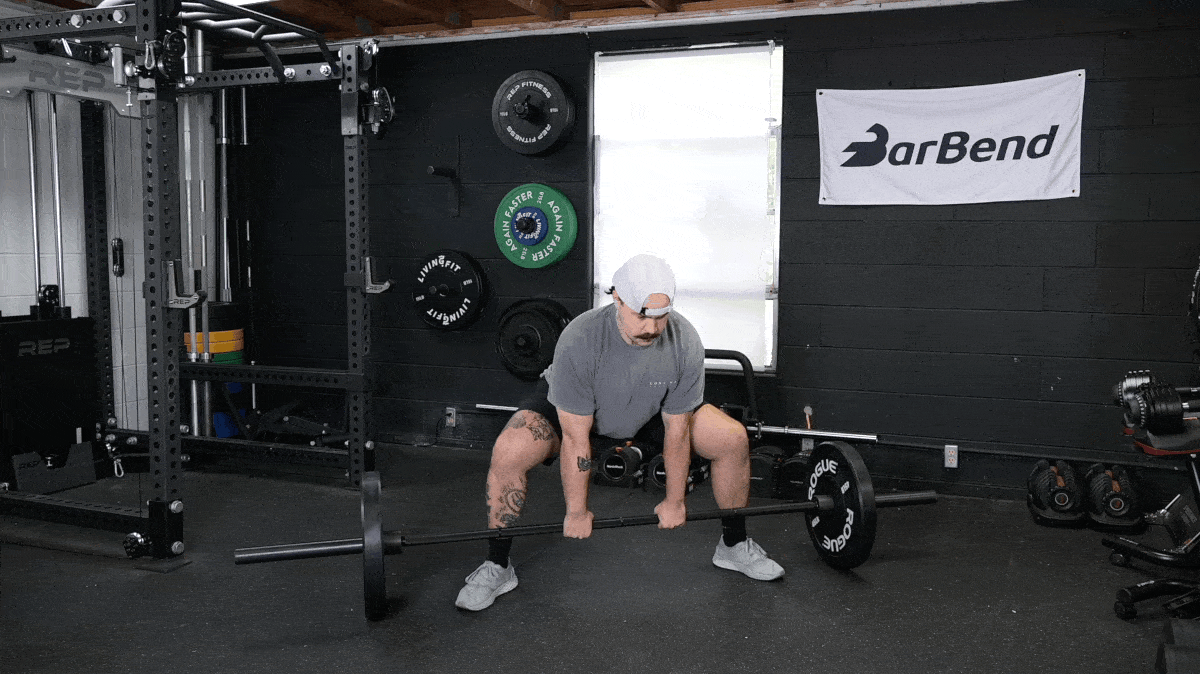
[Read More: Your Definitive Guide to Sumo Versus Conventional Deadlifts]
- Step 1: Take a very wide stance in front of a loaded barbell with your toes pointing outward at a 45-degree angle or more.
- Step 2: Break at the hips and the knees and slowly lower your pelvis down until you can grab the barbell.
- Step 3: Flatten your back and do your best to pull your chest up. Push your knees outward to the side to create a path for the bar.
- Step 4: Push into the floor with your legs to break the bar off the ground. As it passes your knees, snap your hips into extension to fully stand up.
Trap Bar Deadlift
If you have any back issues or have poor hip mobility, you’ll want to try deadlifts on a trap bar. This bar’s hexagon shape allows you to better center your body and align your hips instead of having the barbell in front of you, which puts you at risk of hyperextending your hips.
- Step 1: Load a trap bar frame with some plates and stand within it. Take a close, hip-width stance.
- Step 2: Hinge down and bend your knees until you can reach the handles of the trap bar.
- Step 3: Grab the handles snugly, flatten your back, and brace your core.
- Step 4: With your arms hanging down and a tight grip, push into the floor with your legs and stand up with the weight.
Romanian Deadlift
The Romanian deadlift is similar to the conventional deadlift, save for one key difference: The movement begins at a standing position, bar in-hand, rather than on the floor.
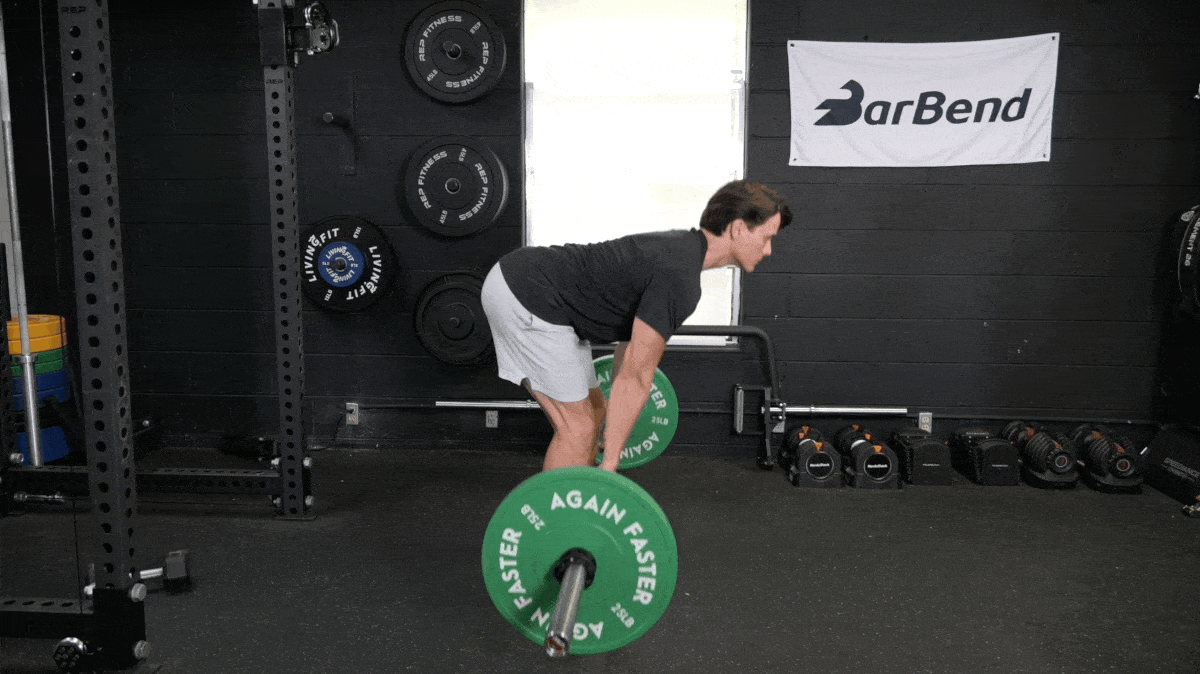
[Read More: Romanian Deadlift vs. Deadlift — Which Is Best for Your Goals?]
- Step 1: Stand upright while holding a barbell in your hands with a close grip and your feet under your hips.
- Step 2: Brace your core and tip over at the waist.
- Step 3: Push your butt backward and sink into a deep hinge as the bar travels down your thighs.
- Step 4: Tip over until the bar reaches your kneecaps, and then reverse the motion by contracting your glutes to push yourself upright again.
Stiff-Leg Deadlift
As the name suggests, stiff-leg deadlifts have you keep your legs as straight as possible when performing a pull from the floor. By deliberately lifting your hips and straightening your legs, you can shift more of the weight onto your hamstrings, glutes, and lower back.
- Step 1: Step up to a loaded barbell and assume your typical stance.
- Step 2: Drop down into the starting position you’d normally use for a conventional deadlift.
- Step 3: Once you’re set up, deliberately elevate your hips by straightening your knees until your torso is parallel to the floor.
- Step 4: Maintain a flat back, feel a tremendous stretch in the backs of your legs, and then contract your posterior chain to stand up with the bar.
Rack Pull
Rack pulls are similar to traditional deadlifts, except you lift the weight with the barbell starting around knee height. The benefit of this is that the range of motion is shorter from a rack pull than other deadlifts, which focuses more on your upper back and traps, places less stress on your lumbar spine.
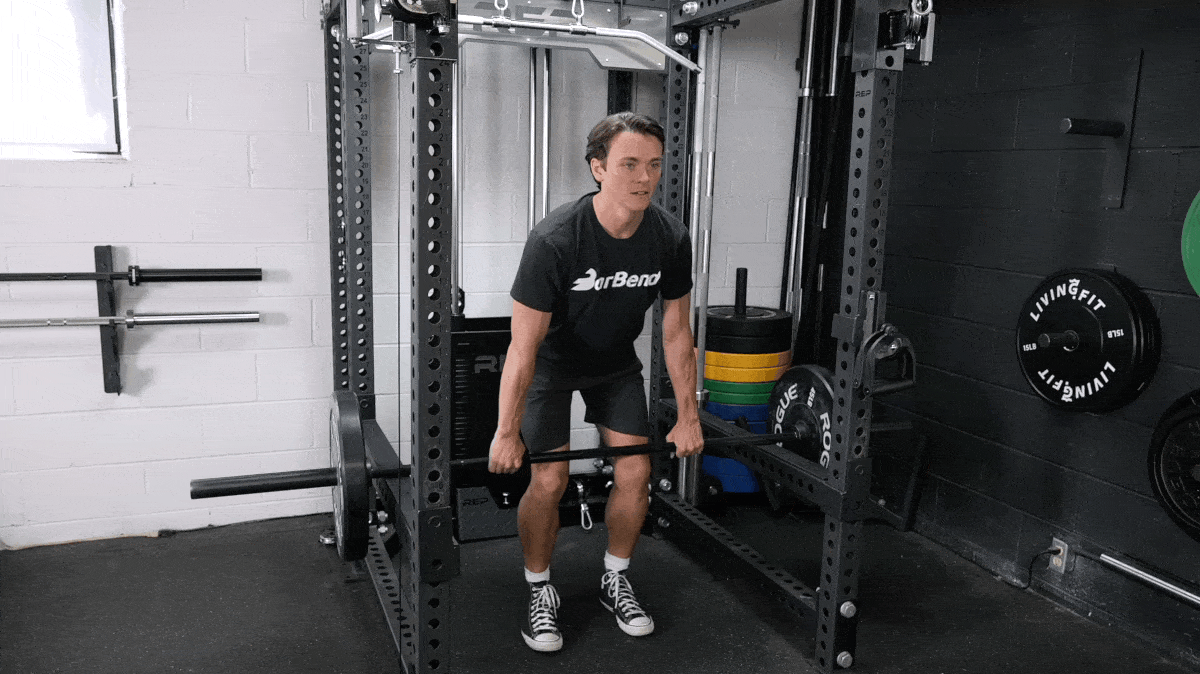
[Read More: Are Rack Pulls Worth It? How to Do Them Correctly]
- Step 1: Set up a heavily-loaded barbell within a squat or power rack such that the bar rests around knee level or slightly higher.
- Step 2: Stand with your feet under your hips, push your butt backward, and hinge down to grab the bar.
- Step 3: Brace your core as hard as you can and aggressively pull the bar off the rack, rising to a standing position with your arms hanging down.
The Big Picture
Do you have to deadlift? No — of course not. But, deadlifts can help you build more muscle, increase strength, enhance your posture, and even improve athleticism. Before you do the movement, though, ensure that you perfect your deadlift form and take the necessary safety precautions.
References
- Vecchio LD, Daewoud H, Green S. The health and performance benefits of the squat, deadlift, and bench press. MOJ Yoga Physical Ther. 2018;3(2):40‒47. DOI: 10.15406/mojypt.2018.03.00042
- Thompson, Brennan J.; Stock, Matt S.; Shields, JoCarol E.; Luera, Micheal J.; Munayer, Ibrahim K.; Mota, Jacob A.; Carrillo, Elias C.; Olinghouse, Kendra D. Barbell Deadlift Training Increases the Rate of Torque Development and Vertical Jump Performance in Novices, Journal of Strength and Conditioning Research: January 2015 – Volume 29 – Issue 1 – p 1-10 doi: 10.1519/JSC.0000000000000691
- Berglund, Lars1,2; Aasa, Björn2; Hellqvist, Jonas1; Michaelson, Peter3; Aasa, Ulrika1 Which Patients With Low Back Pain Benefit From Deadlift Training?, Journal of Strength and Conditioning Research: July 2015 – Volume 29 – Issue 7 – p 1803-1811 doi: 10.1519/JSC.0000000000000837
- Aristizabal, J., Freidenreich, D., Volk, B. et al. Effect of resistance training on resting metabolic rate and its estimation by a dual-energy X-ray absorptiometry metabolic map. Eur J Clin Nutr 69, 831–836 (2015). https://doi.org/10.1038/ejcn.2014.216
- Shaner, Aaron A.1; Vingren, Jakob L.1,2; Hatfield, Disa L.3; Budnar, Ronald G. Jr1; Duplanty, Anthony A.1,2; Hill, David W.1 The Acute Hormonal Response to Free Weight and Machine Weight Resistance Exercise, Journal of Strength and Conditioning Research: April 2014 – Volume 28 – Issue 4 – p 1032-1040 doi: 10.1519/JSC.0000000000000317
- Sharrock C, Cropper J, Mostad J, Johnson M, Malone T. A pilot study of core stability and athletic performance: is there a relationship?. Int J Sports Phys Ther. 2011;6(2):63-74.
- Luke Delvecchio. The Deadlift -Part 1. J Yoga & Physio. 2018; 6(1): 555676. DOI: 10.19080/JYP.2018.06.555676
- Beattie, Kris & Kenny, Ian & Lyons, Mark & Carson, Brian. (2014). The Effect of Strength Training on Performance in Endurance Athletes. Sports Medicine. 44. 845-865. 10.1007/s40279-014-0157-y.
- Nowotny J, Nowotny-Czupryna O, Brzęk A, Kowalczyk A, Czupryna K. Body posture and syndromes of back pain. Ortop Traumatol Rehabil. 2011 Jan-Feb;13(1):59-71. English, Polish. doi: 10.5604/15093492.933788. PMID: 21393649.
- Bohannon RW. Grip Strength: An Indispensable Biomarker For Older Adults. Clin Interv Aging. 2019;14:1681-1691. Published 2019 Oct 1. doi:10.2147/CIA.S194543
Featured Image: oleksboiko /Shutterstock
The post The 12 Deadlifts Benefits You Need to Know About appeared first on BarBend.
